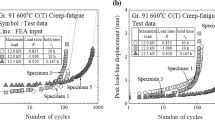Abstract
This paper analyzes the effects of crack tip plastic strains and compressive residual stresses, created by fatigue pre-cracking, on environmentally assisted cracking of pearlitic steel subjected to localized anodic dissolution and hydrogen assisted fracture. In both situations, cyclic crack tip plasticity improves the behaviour of the steel. In the respective cases, the effects are supposed to be due to accelerated local anodic dissolution of the cyclic plastic zone (producing chemical crack blunting) or to the delay of hydrogen entry into the metal caused by residual compressive stresses, thus increasing the fracture load in aggressive environment.
Similar content being viewed by others
REFERENCES
Ford, F.P. (1983). Stress corrosion cracking of iron-base alloys in aqueous envvironments. In: Treatise on Materials Science and Technology, Vol. 25: Embrittlement of Engineering Alloys (Edited by C.L. Briant and S.K. Banerji), Academic Press, New York, 235–274.
Handerhan, K.J. and Garrison, W.M., Jr. (1992). A study of crack tip blunting and the influence of blunting behavior on the fracture toughness of ultra high strength steels. Acta Metallurgica et Materialia 40, 1337–1355.
Kanninen, M.F. and Popelar, C.H. (1985). Advanced Fracture Mechanics, Oxford University Press, New York.
Rice, J.R. (1967). Mechanics of crack tip deformation and extension by fatigue. In: Fatigue Crack Propagation, ASTM STP 415. American Society for Testing and Materials, Philadelphia 247–309.
Toribio, J. and Kharin, V. (1997). K-dominance condition in hydrogen assisted cracking: the role of the far field. Fatigue and Fracture of Engineering Materials and Structures 20, 729–745.
Toribio, J. and Lancha, A.M. (1993). Effect of cold drawing on susceptibility to hydrogen embrittlement of prestressing steel. Materials and Structures 26, 30–37.
Toribio, J. and Lancha, A.M. (1996). Overload retardation effects on stress corrosion behaviour of prestressing steel. Construction and Building Materials 10, 501–505.
Toribio, J., Lancha, A.M. and Elices, M. (1991). Characteristics of the new tearing topography surface. Scripta Metallurgica et Materialia 25, 2239–2244.
Van Leeuwen, H.-P. (1974). The kinetics of hydrogen embrittlement: a quantitative diffusion model. Engineering Fracture Mechanics 6, 141–161.
Author information
Authors and Affiliations
Rights and permissions
About this article
Cite this article
Toribio, J., Kharin, V. Role of crack tip mechanics in stress corrosion cracking of high-strength steels. International Journal of Fracture 126, L57–L63 (2004). https://doi.org/10.1023/B:FRAC.0000026588.31654.e1
Issue Date:
DOI: https://doi.org/10.1023/B:FRAC.0000026588.31654.e1




